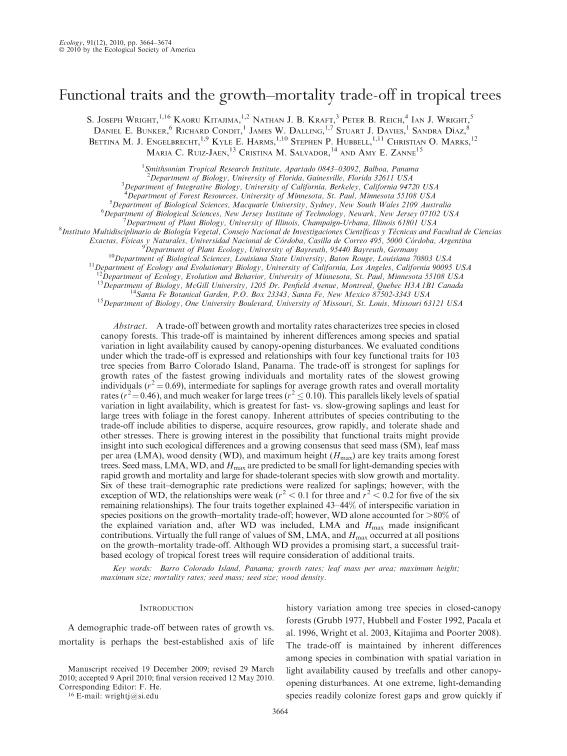Artículo
Functional traits and the growth mortality trade-off in tropical trees
Wright, S. Joseph; Kitajima, Kaoru; Kraft, Nathan J. B.; Reich, Peter B.; Wright, Ian J.; Bunker, Daniel E.; Condit, Richard; Dalling, James W.; Davies, Stuart J.; Diaz, Sandra Myrna ; Engelbrecht, Bettina M. J.; Harms, Kyle E.; Hubbel, Stephen P.; Marks, Christian O.; Ruiz Jaen, María C.; Salvador, Cristina; Zanne, Amy
; Engelbrecht, Bettina M. J.; Harms, Kyle E.; Hubbel, Stephen P.; Marks, Christian O.; Ruiz Jaen, María C.; Salvador, Cristina; Zanne, Amy
 ; Engelbrecht, Bettina M. J.; Harms, Kyle E.; Hubbel, Stephen P.; Marks, Christian O.; Ruiz Jaen, María C.; Salvador, Cristina; Zanne, Amy
; Engelbrecht, Bettina M. J.; Harms, Kyle E.; Hubbel, Stephen P.; Marks, Christian O.; Ruiz Jaen, María C.; Salvador, Cristina; Zanne, Amy
Fecha de publicación:
12/2010
Editorial:
Ecological Society Of America
Revista:
Ecology
ISSN:
0012-9658
Idioma:
Inglés
Tipo de recurso:
Artículo publicado
Clasificación temática:
Resumen
A trade-off between growth and mortality rates characterizes tree species in closed canopy forests. This trade-off is maintained by inherent differences among species and spatial variation in light availability caused by canopy-opening disturbances. We evaluated conditions under which the trade-off is expressed and relationships with four key functional traits for 103 tree species from Barro Colorado Island, Panama. The trade-off is strongest for saplings for growth rates of the fastest growing individuals and mortality rates of the slowest growing individuals (r2 = 0.69), intermediate for saplings for average growth rates and overall mortality rates (r2 = 0.46), and much weaker for large trees (r2 ≤ 0.10). This parallels likely levels of spatial variation in light availability, which is greatest for fast- vs. slow-growing saplings and least for large trees with foliage in the forest canopy. Inherent attributes of species contributing to the trade-off include abilities to disperse, acquire resources, grow rapidly, and tolerate shade and other stresses. There is growing interest in the possibility that functional traits might provide insight into such ecological differences and a growing consensus that seed mass (SM), leaf mass per area (LMA), wood density (WD), and maximum height (Hmax) are key traits among forest trees. Seed mass, LMA, WD, and Hmax are predicted to be small for light-demanding species with rapid growth and mortality and large for shade-tolerant species with slow growth and mortality. Six of these trait–demographic rate predictions were realized for saplings; however, with the exception of WD, the relationships were weak (r2 < 0.1 for three and r2 < 0.2 for five of the six remaining relationships). The four traits together explained 43–44% of interspecific variation in species positions on the growth–mortality trade-off; however, WD alone accounted for >80% of the explained variation and, after WD was included, LMA and Hmax made insignificant contributions. Virtually the full range of values of SM, LMA, and Hmax occurred at all positions on the growth–mortality trade-off. Although WD provides a promising start, a successful trait-based ecology of tropical forest trees will require consideration of additional traits.
Archivos asociados
Licencia
Identificadores
Colecciones
Articulos(IMBIV)
Articulos de INST.MULTIDISCIPL.DE BIOLOGIA VEGETAL (P)
Articulos de INST.MULTIDISCIPL.DE BIOLOGIA VEGETAL (P)
Citación
Wright, S. Joseph; Kitajima, Kaoru; Kraft, Nathan J. B.; Reich, Peter B.; Wright, Ian J.; et al.; Functional traits and the growth mortality trade-off in tropical trees; Ecological Society Of America; Ecology; 91; 12; 12-2010; 3664-3674
Compartir
Altmétricas



